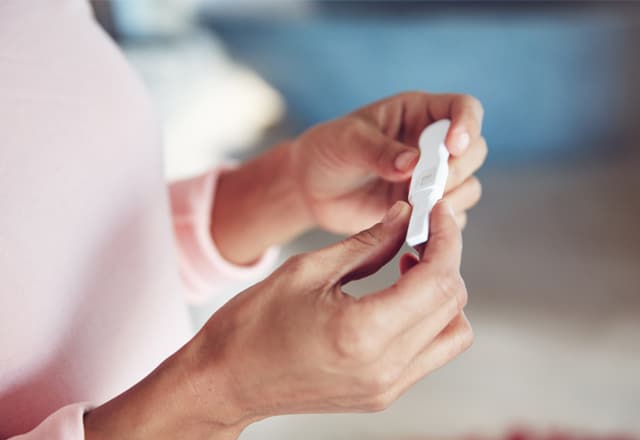Sometimes it seems like trying to get pregnant is all about waiting. You’re waiting for your ovulation predictor kit to tell you it’s time to have sex. You’re waiting for the first possible day you can take a pregnancy test. Then, you’re waiting on the edge of your seats for the results.
Most women trying to conceive, whether it be naturally or with the aid of fertility treatment, have taken a pregnancy test at some point. Regardless of the method, be it a home pregnancy test or through a blood test at the fertility center, almost every woman is on pins and needles while waiting to learn when there are going to be a mother.
In the fertility world, the time between a pregnancy attempt and a pregnancy test is commonly called the ‘two week wait’. Why so long before testing? “The reason women should not take home pregnancy test until two weeks after possible conception is because several days are required for a fertilized egg to implant in the uterus and start emitting enough hormones to be detected by a pregnancy test.” explains Dr. Eric Levens, reproductive endocrinologist at Shady Grove Fertility’s Fairfax, VA office.
During the two weeks wait: your body
The best way to make decisions about what kinds of things to do and not do during this time is to act as if you’re already pregnant….because you may be.
In terms of nutritional choices, that means eating a well-balanced diet, avoiding foods that are not recommended during pregnancy like raw fish and soft cheeses and taking a preconception supplement daily. Avoid alcohol and caffeine as well as over-the-counter drugs that are not recommended during pregnancy.
In terms of physical activities, it’s a good idea to take it easy and try to be restful and relaxed. “Some of the recommendations we give fertility patients about physical activity could also be helpful to women trying on their own.” says Levens.
For example, we suggest that patients take it easy for three or four days after an insemination or embryo transfer to allow the embryo the best chance for implanting in the uterus. They can go back to work and lead their normal lives but strenuous exercise, chores and even sex should be avoided. Anything that causes uterine contractions could affect the implantation process.
After those few days, patients can go back to light aerobic activities like yoga, swimming or walking. It’s alright to get the heart rate up; they just need to avoid high impact activities like running.
“We also tell fertility patients that it’s best to avoid travel during the two week wait so that they’ll be near their doctor should any complications, like bleeding, arise.” says Levens. Also, many aspects of travel, such as time zone changes and carrying luggage, can stress a woman’s mind and body. If they have to travel, we ask patients to check with their medical team about what kinds of precautions they can take.
One recommendation specific to fertility patients is 24 hours of “couch rest” after an embryo transfer. Fertility patients are asked to take the day off, put their feet up and rest as much as possible the day after this procedure like an embryo transfer.
Fertility patients also continue to take medications throughout the two week wait to support the uterine lining and the development of the embryo.
During the two week wait: your mind
Probably the hardest thing about the two week wait is the hamster wheel your mind seems to be on – the endless stream of “what ifs” and the hyper alertness to every sensation in your body. This is where we could all use some real support and strategies for coping.
Here are some tips you can use to calm your mind:
- Visit the Shady Grove Fertility Facebook page to get support and tips for passing the time from others who have been through it.
- Try not to obsess about symptoms. Don’t spend all day online reading articles and chatboards about pregnancy symptoms. The hormones surrounding pregnancy attempts can produce feelings in your body that can be confusing – either making you think you are or aren’t pregnant. It’s impossible to divine the answer with intuition, so just resign yourself to waiting for the test results.
- Treat yourself by spending time doing the things you enjoy the most: preparing a nice meal, going to the movies or curling up with a good book.
- Try deep breathing as a calming technique. A few minutes of intentional breathing with your eyes closed can really lower your stress level and clear your mind.
- Use positive thinking. If you’re anxious and, especially if you’ve been trying to get pregnant for a while, you may be having negative thoughts, like “The results are going to be negative. I’m never going to get pregnant.” When you hear yourself saying or thinking these kinds of things, try re-stating them as positive or neutral statements such as, “I don’t know the outcome yet, but I’ve done all I can to make it happen.”
- Plan for the day you’ll get the results and for the days after. Knowing what comes next after either a negative or positive can help you avoid anxiety in the aftermath of your results.
The key thing is to remind yourself that you can’t control the outcome. You’ve done everything you can to make it happen, and now you just have to let go and let nature take its course.
The Pregnancy Test
“Both home pregnancy tests (HPTs) and pregnancy tests done at a lab measure the amount of human chorionic gonadotropin (hCG) being made by the developing embryo.” says Dr. Eric Levens. The home pregnancy test uses urine while the lab test uses blood. Home pregnancy tests work well when they are used on the right day, but the results of the blood test are always more accurate.
If you use a home pregnancy test, be sure to read all the instructions and try to use morning urine, which will be the most concentrated. HPTs usually tell consumers how accurate they are depending on the day you use them. For example, four days before the first day of your missed period, the HPT may only be 45% accurate.
The blood pregnancy test is frequently called a “beta.” That’s because the test actually measures a beta chain portion of the hCG hormone molecule and is officially named a “beta hCG” test.
Whereas a home pregnancy test only tells you positive or negative, a beta hCG test provides the level of hCG in the blood. This level is important to checking the growth of the embryo.
Fertility patients are advised not to use home pregnancy tests and to wait for the date they can have a beta test done. Home pregnancy tests can render false results for fertility patients, either negative or positive. A false positive can be the result of the fact that in many fertility treatments, hCG is given to “trigger” ovulation and may remain in the blood. A false negative might occur because a low level of hCG may be undetectable in a urine test despite a pregnancy starting.

When the test is positive
For women trying on their own, a positive home pregnancy test should be followed by a lab-drawn beta test ordered by their ob/gyn. Once the pregnancy is confirmed by the blood test, they should start regular obstetrics care with their doctor.
For fertility patients, the process happens under the care of their fertility specialist. “If the first beta test is positive, it will be repeated in 2 to 3 days. A blood hCG level over 100 is a good first result but many, many ongoing pregnancies start out with a beta hCG level below that number. Many people wrongly believe a high beta level means a multiple pregnancy, but a multiple pregnancy can only be confirmed by ultrasound.
We are looking for the level of hCG to increase 66% percent or more during that time. If it does, another beta will be ordered for 2-3 days later and the number should increase by 66% or more again. If all three betas indicate a pregnancy, then a vaginal ultrasound will be scheduled between the 6-8week mark of the pregnancy.” explains Dr Levens “At that time, we will be looking for a heartbeat and a gestational sac to confirm the pregnancy.”
“Most patients will continue to take hormone medications throughout this 8-week period to support the developing pregnancy.” says Dr. Levens. Generally your medical team will advise you individually on the duration of continuing medications. At the end of 8 weeks, the patient will be released back to her ob/gyn to begin normal prenatal care.
If the results are negative
When a woman gets a negative result on any pregnancy test, it’s disappointing. Often she wants to know how soon she can try again. In many cases, there is no need to wait and she can try again on her next cycle.
Fertility patients are instructed to stop their medications and consult with their care team. At this time patients can discuss what happened during their failed cycle and make a plan for their next steps. Try to stay positive and keep moving forward on your treatment plan, you are stronger than you think.
Even with fertility treatments such as IUI treatment, it’s usually not necessary to take time off. Most couples can start another cycle right away. IVF treatment, however, may require a slightly longer wait before starting another treatment cycle to allow the patient and physician to get ready for the next cycle. This period of time is usually a month or two.
Don’t wait too long before getting the help you need
Shady Grove Fertility’s physicians are committed to helping you conceive in the most efficient and cost-effective way possible.
When to seek help from an infertility specialist:
- Under 35 with regular cycles, unprotected intercourse and no pregnancy after 1 year
- 35 to 39 with regular cycles, unprotected intercourse and no pregnancy after 6 months
- 40 or over with regular cycles, unprotected intercourse, more immediate evaluation and treatment are warranted
A patient who’s been unsuccessful after several cycles of the same treatment should speak with their physician about considering a more advanced form of fertility treatment.
If you are having trouble conceiving and would like to schedule an appointment, please speak with our New Patient Center by calling 1.888.761.1967 or complete this brief online form.





